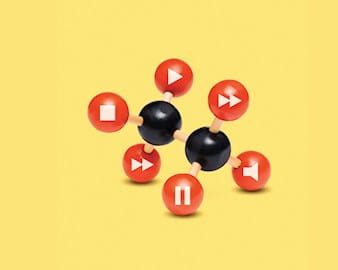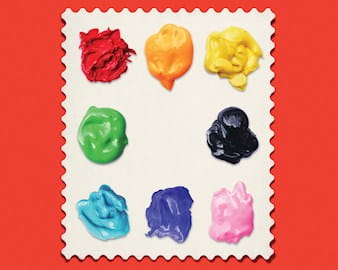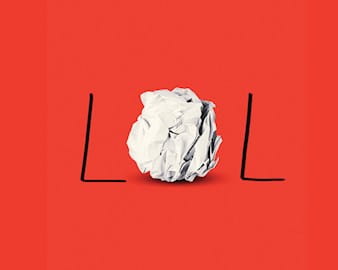
Booth alumni weigh in on harnessing the power of creative thinking at the office.
- By
- May 01, 2018
- Innovation

These days, companies are deploying creative thinking across departments while replacing strict office policies with opportunities to tinker. Firms are allowing employees time to test out ideas, encouraging new concepts without a fear of failure, and building out collaborative, couch-filled office environments.
It’s not a one-size-fits-all approach, and tapping into the potential of creative thinking can be a challenge.
Striking the delicate balance between brainstorming ideas and moving forward on a project is one way Ted Wright, ’00, founder of Fizz, a word-of-mouth-marketing agency headquartered in Atlanta, taps into his own creative abilities. When Wright works with clients, one of his strategies is to use hard data as the backbone for creative thinking without heading straight for the answer. In the beginning of each project, he and his team spend hours gathering data on 53 questions in 18 categories to get an idea of the client objectives. Back at the office, teams set aside time for idea generation based on the results.
“If you start to care what the answers are, you throw a lid on creativity. The trick is knowing that it’s a journey,” he said.
Wright is not the only one figuring out ways to encourage this kind of open-ended thinking at work. Here are some other ways alumni create opportunities for creativity:

For Nicole Farb, ’09, creative thinking means setting aside time to gather new ideas and experiment with them. This time facilitates vital new thinking to help grow Farb’s San Francisco–based business, Darby Smart, a website where users can share, watch, and shop videos. “In my own life, creativity is a journey,” said Farb. “I’m often doing it for the process, not the outcome.” Farb intentionally sets aside open blocks of time for less structured thinking while brainstorming initial ideas.
Often, that means testing out what connects with her audience without overthinking results or being overly focused on emulating the highly produced creative content shown on television. Farb has learned to experiment constantly, a critical creative skill in a media landscape of near-instant digital content and a steady stream of new content tools and platforms. “A perfect commercial is not what resonates on social media today,” Farb pointed out. “Brainstorming new ideas is key for our business because different styles of videos are resonating with different age groups.”
Booth taught students to challenge everything. It’s the same with creativity; so much of the problem-solving I do requires me to push beyond the immediate and beyond the obvious.
— Mauresa Pittman

For Mauresa Pittman, ’10, creative opportunities factored little when she applied for her current job as a marketing and client relationship manager at the US Postal Service. Her experience on the job, however, transformed her view on the meaning of creative work. Pittman regularly taps into her own power of creativity in managing the stamp development process. In her job, Pittman sets strategic direction for future stamps and philatelic activities, including creative development for the USPS’s commemorative stamp program. “Often, in a government organization, following documented standard operating procedures is deeply ingrained into the culture and those behaviors can stay unchanged for years,” she said. “Being new to government has allowed me to ask: ‘Why don’t we think of the endeavor a little bit differently?’”
Pittman previously worked as a brand manager focusing on package redesign for V8 Splash at the Campbell Soup Company. As she adjusts to her role at USPS, she harnesses similar creative knowledge to build the USPS brand as she did the V8 brand. “At Campbell Soup, the creative brief for a package design, for example, was king,” she said. “In the government, there isn’t that formality, but you still have a finite amount of space to design a postage stamp,” she said. “What this position has offered me in terms of creativity has been unexpected.”
Pittman traces her success with expanding her own—and USPS’s—creative capabilities to an ethos ingrained during her time at Booth. “Booth taught students to challenge everything,” she said. “It’s the same with creativity; so much of the problem-solving I do requires me to push beyond the immediate and beyond the obvious.”
In Pittman’s case, deploying her own creative-thinking skills doesn’t end at the brainstorming stage. Indeed, she considers the most imaginative part of her role at the USPS to be distilling her own creative process down to a tiny stamp. This process requires plenty of out-of-the-box thinking. Recently, Pittman delved into research on the late Pennsylvania painter Andrew Wyeth. “The creative challenge became, how do we sum up one of the most prominent American artists of the 20th century in a pane of 12 stamps,” she said.
Pittman now needs to spend more time editing what goes onto a stamp to the very essence of the paintings, a creative process that can be unexpectedly challenging.
Telling the story of a prominent artist in a space the size of a postage stamp—literally—presents its own creative demands. “It can be tricky because the stamp is small—it’s a tiny piece of real estate that needs to say a lot without the benefit of paragraphs of text to explain,” Pittman said. To get the message just right, a team of art directors can tinker for months with anything from crops to color collections to even the smallest design details. The art process sometimes starts with a black-and-white sketch, which is later recreated digitally. Once the art is in its final phase, family members or the commercial entity associated with the subject are also provided a copy. “We want both parties to feel proud of the final result,” said Pittman of what’s often a yearlong process.
Even unexpected hiccups can call for on-the-spot creative thinking. A recent prominent person honored on a stamp required an unusually complex vetting process—Pittman had to track down several heirs to ask them to give permission for the stamp. “It can get very complicated very quickly when it comes to rights of publicity,” she said.

At Darby Smart, Farb has built out spaces that encourage creativity. Last year, she built a crafting station with spray paint and materials to help employees disconnect from the online world by working with their hands. “It doesn’t take a ton of work to design this kind of space,” said Farb, who appears on ABC’s Good Morning America to host a monthly segment on creative projects. “I believe that not everything needs to be perfect, and you should set a variety of expectations for yourself.”
Farb believes in integrating creativity both inside and outside of the workplace. She taps into creative thinking to tackle problems when she’s off the clock. “It’s the core of my business, but it’s also how I bond with my children,” said the mother of two.
For Pittman, being away from the office—especially during her train commute to work—can trigger new ideas and help her consider solutions to existing creative problems. The change of pace can help her rewire her thought process in a way that may be more difficult between meetings, she added. Getting away from her desk was especially valuable during a recent complex stamp project, to commemorate the 50th anniversary of the superhero Wonder Woman. Pittman’s team developed multiple stamps commemorating the character through the ages.
She also uses time away from the office to think through sensitivities or biases related to each stamp subject. “Each time, we need to consider how this message could land with different audiences and ask ourselves if we are being mindful of the diverse viewpoints,” she added.
The first time you put limits on somebody, a nanosecond later, you start to lose creativity.
— Ted Wright

In Wright’s case, harnessing creativity has meant giving employees the courage to embrace their own bad ideas. Several years ago, the marketing entrepreneur designated an office area where employees can use black-light markers to make note of their worst ideas. When an especially terrible idea is said aloud during a meeting, an employee can document it on the wall. While the wall of failure is typically invisible in the light, when fluorescent lights are dimmed, black-light lamps reveal what’s scrawled on it. “It starts to signal to people that if you have an idea—good or bad—share it,” he said. “There are no limits because the first time you put limits on somebody, a nanosecond later, you start to lose creativity.”
The light-hearted collection allows employees room to fail, rather than have their bad ideas pointed out in a serious way. Employees become comfortable sharing ideas they might otherwise suppress for fear of ridicule or censure. “You have to be willing to call people out, even if you’re the boss,” Wright said. “But the moment you start to be judgmental is the moment you start to reduce creativity. You have to truly believe that the best ideas come through collaboration. This allows other people to build off of that germ of an idea.”
When it comes to embracing creativity, Farb has learned the value of failing quickly and moving on to the next opportunity without getting sidetracked by that failure. Admitting a project or video took the wrong direction can help open up other opportunities for creativity more quickly. “There’s a cultural value to failing fast,” she said.
For Farb, trying out new concepts on her own has been the key to Darby Smart’s growth. Recently, the former technology investment banker at Goldman Sachs made a beauty-related video of her own routine for the first time. Publishing it online was “scary because you might not get a reaction, but I always feel that’s part of the journey,” she admitted. But as she pushes the limits of video publishing, this kind of exercise is paying off. “People are generally pretty receptive when you’re honest and authentic,” she added.
Farb’s experimental ethos blossomed at an early age. In her first business, Farb and her sister sold hair accessories to other neighborhood schoolchildren. With her Darby Smart employees, she encourages the same type of innovative thinking. “Everyone is inherently creative,” she said. “It’s your own expression and we’re bringing it back.”
Wright embraces vulnerability on his teams by prioritizing the creative process over the perfect answer as a project gets under way. “We don’t care what the answer is from the very beginning. You arrive at the answer after understanding the story, target, and goal,” he said.
At Fizz, Wright uses what has proved to be a winning formula: “Data plus will equals creativity,” he said. Creative thinking can be used alongside the increasing amounts of data available as a means to fine-tune direction. But data isn’t just numbers and spreadsheets. It’s all forms and formats of information, including pictures of employees in a newsletter and kids’ thank-you drawings taped to the side of a desk.
Recently, Wright worked with JetBlue on an awareness program around its existing initiative to make flying more accessible for families and children with autism. The program started as a grassroots initiative by the airline’s crewmembers who wanted to better meet the needs of the autism community. When Wright initially met with the airline, he learned that some of its crewmembers were coordinating field trips, inviting kids on the autism spectrum and their families to the airport to practice the travel and airport experience.
Anxiety, long lines, loud noises, and unfamiliarity all come into play when navigating the airport. These trips are used as a trial to help families determine if air travel is a possibility for them before making a commitment and purchasing flights. Several times a year, families are invited to select airports in JetBlue’s network to rehearse the experience, go through security, and try out boarding the plane.
The program is continuing to grow and will roll out across more airports in the near future. Highlighting this opportunity tells a story of how committed the airline is, and how willing it is to find new ways to help and care for its customers, Wright said. “JetBlue is already known for exemplary customer service and innovation,” he said. “This is an example of what differentiates them from other travel providers.”
When taking on a new project, Wright starts by asking the client to gather data, and builds a solid foundation for creative thinking back at the office. This means he and his teams can spend weeks on end finding data to gain an understanding of their client. “We start by asking a lot of questions about your company,” he said. “For us, creativity starts with what the story is that you are trying to communicate to people.”
We'd love to hear your Booth memories, stories, connections...everything.